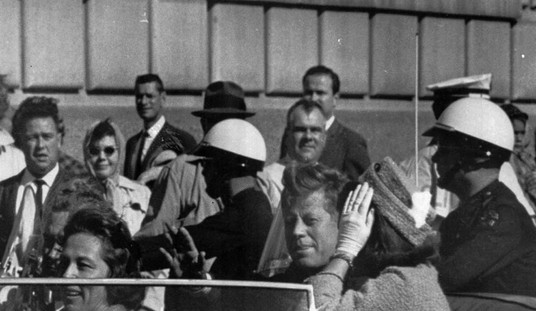Out here on the Left Coast, it is beginning to dawn on people that when you release criminals from custody in the name of “prison reform,” it is only the prisons themselves that are reformed. The criminals, those who are ushered out the prison gates into an unwary society, remain as un-reformed as ever.
For proof of this, I present as Exhibit A one Michael C. Mejia, age 26, who stands accused of murdering two people in Southern California, one of them a police officer. Police allege that on Monday morning Mejia killed his cousin, Roy Torres, in East Los Angeles and stole his car. Later, while driving the stolen car in Whittier, a suburb about 12 miles southeast of downtown L.A., Mejia rear-ended another car. When police responded to the report of a minor traffic accident, Mejia opened fire on them, killing Officer Keith Boyer and wounding Officer Patrick Hazell. Mejia was himself wounded in the gun battle but is expected to survive.
In recent years, California has enacted a series of reforms to its criminal justice system, the net effect of which has been the lowering of the state’s prison population. In 2011, the state legislature passed Assembly Bill 109, which brought about a so-called “realignment” in penal responsibilities, shifting some of them from the state to the counties. Since AB 109’s enactment, some felons who would have served time in state prisons are now housed in county jails. Also, some parolees who would have been under the supervision of state parole officers are now monitored by county probation departments. Mejia, about whom more later, was one such parolee.
Proposition 47 was passed by California voters in 2014. The measure redefined some felony crimes, i.e., those deemed to be not serious or violent, as misdemeanors. Most thefts of property valued at less than $950 were thus downgraded, as was the possession for personal use of cocaine, heroin, and methamphetamine.
Last November saw the passage of California’s Proposition 57, which authorized the early release of felons whose crimes are deemed nonviolent. This may sound reasonable until one examines the list of crimes so regarded, which includes assault with a deadly weapon, battery with serious injury, solicitation to commit murder, rape of an unconscious person, and burglary of a home.
Whatever the inanity of any of these measures, they were duly passed and enacted, and we who opposed them are no less obliged to follow them. Still, one cannot help but note the fact that crime in California, both violent and nonviolent, is increasing (PDF). This calls into question the wisdom of any measure whose aim is to diminish the deterrent effect of the state’s penal system. In a rational world, which of course excludes California, such an increase in crime would invite calls to make punishments more severe, not less.
Strictly speaking, Mr. Mejia was not a beneficiary of any of these reform measures. In a Thursday editorial, the Los Angeles Times points out that Mejia served his most recent stint in prison for auto theft, and that he served the full sentence handed down at the time he was convicted. The only effect AB 109 had on Mejia was placing him under the supervision of the L.A. County Probation Department rather than state parole agents. It’s unlikely Mejia would have been any more deterred from further crime under the pre-AB 109 arrangement than he manifestly was under the current one.
So, even if Mejia is not, as some have claimed, a poster boy for the folly of California’s recent reforms to its criminal justice system, he is a glowing example of that system’s failure to safeguard the public against those who cannot be trusted to live among their law-abiding neighbors, and a further example of the crying need for stricter punishments for those who show no willingness to curb their predatory habits. Since his most recent release from prison last April, he was arrested no less than four times and jailed briefly for violating the conditions of his release. Clearly, these brief stays behind bars were insufficient to deter Mejia from further crime. His most recent release from jail came on Feb. 11, so the best that can be said about him is that he was “rehabilitated” for ten days before committing two murders.
As reported by the Los Angeles Times, Mejia was staying with his grandfather in East L.A. since his release from prison. The grandfather called Mejia’s probation officer several times to report his drug use, which the Times labeled as a “struggle” with methamphetamine addiction. Perhaps it was a struggle for Mejia, but perhaps it was no more than a personal preference, an appetite for meth that he had no desire to curb.
Which brings us to another of California’s misguided “reforms” to its criminal justice system, Proposition 36, which was passed by the voters in 2000. Proposition 36 established alternative measures for dealing with people convicted of possessing drugs, diverting them to treatment rather than jail. Again, this sounds good in theory, but experience has shown that, absent the threat of jail time, drug treatment in most cases is all but useless and regarded as a joke by serious addicts. And whatever threat of incarceration for drug crimes that might have remained after Proposition 36 was removed by Proposition 47.
Sadly, the mindset that brought these laws into being persists, and treating drug addiction as a public health problem rather than one of public safety is all the rage. Writing for City Journal this week, Theodore Dalrymple examines the latest surgeon general’s report on addiction and its emphasis on neuroscience. The report argues, says Dalrymple, that “there is no relevant moral or typological difference between, say, Parkinson’s disease and addiction: a point of view that, implicitly and without recognition perhaps, is contradicted by much of what follows in the report itself.”
Michael Mejia had demonstrated long before this week that he was the very sort of person who must be kept safely away from his potential victims. In this most elemental function of government, it failed, and now two people have lost their lives for the failure.
In 2010, the U.S. Supreme Court decided the case of Brown v. Plata (PDF), in which it upheld a lower court ruling that ordered California to decrease its prison population. Unfortunately, the court had no power to decrease the population of those whose conduct would merit a prison sentence. Writing in dissent, Justice Alito wrote:
I fear that today’s decision, like prior prisoner release orders, will lead to a grim roster of victims. I hope that I am wrong.
In a few years, we will see.
Those few years have now gone by, and now we see.










Join the conversation as a VIP Member